- Clone
- 4C11A11 (See other available formats)
- Regulatory Status
- RUO
- Other Names
- MMAC1, BZS, TEP1, MHAM1, GLM2, PTEN1
- Isotype
- Mouse IgG2b, κ
- Ave. Rating
- Submit a Review
- Product Citations
- publications
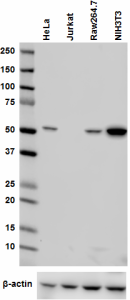
-

Total lysates (15 µg protein) from HeLa (Human, Positive control), Jurkat (Human, Low expression negative control), Raw264.7 (Mouse) and NIH3T3 (Mouse) cells were resolved by electrophoresis (4-20% Tris-glycine gel), transferred to nitrocellulose, and probed with 1:500 (1 µg/ml) purified anti-PTEN antibody, clone 4C11A11. Proteins were visualized using chemiluminescence detection by incubation with HRP Goat anti-Mouse secondary antibody (Cat. No. 405306, 1:3000 dilution). Direct-Blot™ HRP anti-β-actin antibody was used as a loading control (Cat. No. 643807, 1:8000 dilution). -
Total cell lysate from NIH3T3 cells (lane 1, 15 µg), PC3 cells (lane 2, 15 ug) and HeLa cells (lane 3, 15 µg) were resolved by electrophoresis (4-20% Tris-Glycine gel), transferred to nitrocellulose, and probed with purified anti-PTEN antibody (clone 4C11A11) antibody. Proteins were visualized using an HRP Goat anti-mouse IgG Antibody and chemiluminescence detection. Purified anti-β-actin antibody (poly6221) was used as a loading control. -

MCF7 cells were stained with purified anti-PTEN (4C11A11) antibody, followed by staining with DyLight™ 488 conjugated goat anti-mouse IgG (green) antibody. Nuclei were stained with DAPI (blue).
| Cat # | Size | Price | Quantity Check Availability | Save | ||
|---|---|---|---|---|---|---|
| 655002 | 100 µg | 212€ | ||||
PTEN was discovered as a tumor suppressor with lipid and protein phosphatase activity. Heterozygous loss of PTEN in mice contribute to the development of a variety of types of cancer, suggesting that insufficient PTEN activity results in increased cancer susceptibility. PTEN negatively regulates the PI3K/AKT pathway by dephosphorylating the second messenger phosphoinositide 3,4,5-triphosphate (PIP3) produced by phosphoinositide 3-kinase (PI3K), which results in inhibition of abnormal cell proliferation. Despite the hydrolysis function of PIP3, the nuclear population of PTEN possesses greater tumor suppressive activities, regulates gene expression, differentiation, and cell cycle progression.
Product DetailsProduct Details
- Verified Reactivity
- Human, Mouse
- Antibody Type
- Monoclonal
- Host Species
- Mouse
- Immunogen
- Partial human PTEN recombinant protein (303-403aa)
- Formulation
-
This antibody is provided in phosphate-buffered solution, pH 7.2, containing 0.09% sodium azide.
Previous lots of this product may have been formulated with 0.1% or 0.05% NaN3 instead of 0.09% NaN3. For further information please contact BioLegend Technical Support or Customer Service. - Preparation
- Affinity purified.
- Concentration
- 0.5 mg/ml
- Storage & Handling
- Upon receipt, store undiluted between 2°C and 8°C.
- Application
-
WB - Quality tested
ICC - Verified - Recommended Usage
-
Each lot of this antibody is quality control tested by Western blotting. For Western blotting, the suggested use of this reagent is 0.5 - 2.5 µg per ml. For immunocytochemistry, a concentration range of 2.5 - 5.0 µg/ml is recommended. It is recommended that the reagent be titrated for optimal performance for each application.
- Application Notes
-
The binding of PTEN antibody (4C11A11) to its target is sensitive to salt concentration. Please use the Biolegend recommended TBS/T buffer for Western blotting.
- Product Citations
-
- RRID
-
AB_2561892 (BioLegend Cat. No. 655002)
Antigen Details
- Structure
- 403 amino acids, predicted molecular weight of 47 kD, and observed molecular weight of 54 kD. Contains a C2 tensin-like domain responsible for lipid binding and membrane localization.
- Distribution
-
Cytoplasm (unubiquitinated form); nucleus (mono-ubiquitinated form).
- Function
- PTEN functions as a tumor suppressor, modulating the PI3K-AKT-mTOR signaling pathway. It exerts phosphatase activity, dephosphorylating serine, threonine, and tyrosine phosphorylated proteins. In addition, dephosphorylates phospholipids, removing a phosphate from phosphatidylinositol-3,4,5-trisphosphate. The lipid phosphatase activity is required for its tumor suppressor function.
- Interaction
- Interacts with MAIG2, MAIG3, MAST1, MAST3, NEDD4, NDFIP1, NDFIP2, USP7, ROCK1, and XIAP. The unphosphorylated form interacts with AIP1, DLG1 and MAS.T2.
- Biology Area
- Angiogenesis, Apoptosis/Tumor Suppressors/Cell Death, Cell Biology, Cell Cycle/DNA Replication, Signal Transduction, Transcription Factors
- Molecular Family
- Protein Kinases/Phosphatase
- Antigen References
-
1. Carracedo A, et al. 2011. Cancer Res. 71:629.
2. Jiang BH and Liu LZ. 2009. Adv Cancer Res. 102:19.
3. Mao JH, et al. 2008. Science 321:1499.
4. Weng LP, et al. 2001. Hum. Mol. Genet. 10:599.
5. Wrighton KH. 2011. Nat Rev Cancer. 11:154.
6. Wang X, et al. 2007. Cell 128:129. - Gene ID
- 5728 View all products for this Gene ID
- UniProt
- View information about PTEN on UniProt.org
Related FAQs
Other Formats
View All PTEN Reagents Request Custom Conjugation| Description | Clone | Applications |
|---|---|---|
| Purified anti-PTEN | 4C11A11 | WB,ICC |
Customers Also Purchased
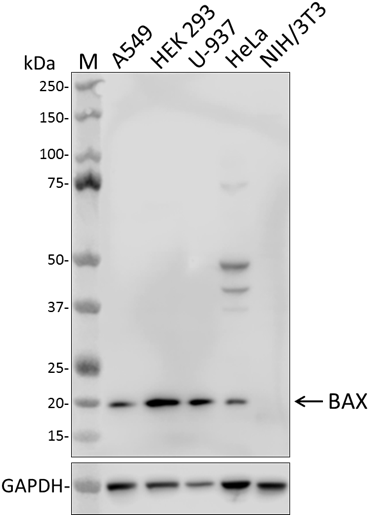
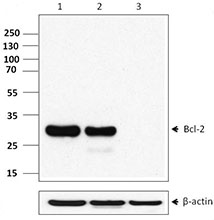
Compare Data Across All Formats
This data display is provided for general comparisons between formats.
Your actual data may vary due to variations in samples, target cells, instruments and their settings, staining conditions, and other factors.
If you need assistance with selecting the best format contact our expert technical support team.
 Login / Register
Login / Register 





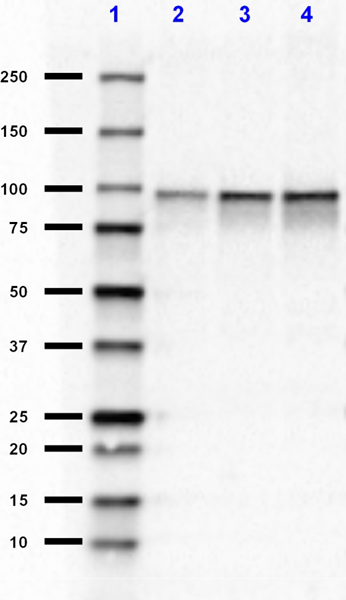



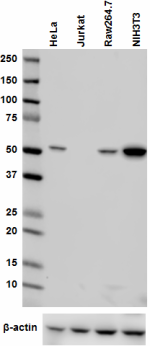



Follow Us